2015 Philadelphia train derailment
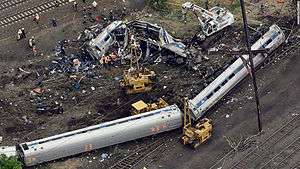 | |
| Date | May 12, 2015 |
|---|---|
| Time | 9:23 p.m. EDT (UTC−4) |
| Location | Port Richmond, Philadelphia, Pennsylvania |
| Coordinates | 40°00′06″N 75°05′37″W / 40.00167°N 75.09361°WCoordinates: 40°00′06″N 75°05′37″W / 40.00167°N 75.09361°W |
| Rail line | Northeast Corridor |
| Operator | Amtrak |
| Type of incident | Derailment |
| Cause | Loss of situational awareness by train engineer |
| Statistics | |
| Trains | 1 (locomotive plus seven cars) |
| Passengers | 238 |
| Crew | 5 |
| Deaths | 8[1] |
| Injuries | 200+[2] |
On May 12, 2015, an Amtrak Northeast Regional train from Washington, D.C. bound for New York City derailed and crashed on the Northeast Corridor in the Port Richmond neighborhood of Philadelphia, Pennsylvania. Of 238 passengers and 5 crew on board, 8 were killed and over 200 injured, 11 critically. The train was traveling at 102 mph (164 km/h) in a 50 mph (80 km/h) zone of curved tracks when it derailed.
Some of the passengers had to be extricated from the crashed cars. Many of the passengers and local residents helped first responders during the rescue operation. Five local hospitals treated the injured. The derailment disrupted train service for several days.
The National Transportation Safety Board ruled that the derailment was caused by the train's engineer becoming distracted by other radio transmissions and losing situational awareness, and said that it would have been prevented by positive train control, a computerized speed-limiting system that was operational elsewhere on the Northeast Corridor, but whose activation at the crash site had been delayed due to regulatory requirements. The track in question was also not equipped with ATC (automatic train control), an older and simpler system which had been operational for years on the southbound track of the curve at which the derailment occurred, and which also would have limited the train's speed entering the curve.[3] Shortly after the derailment, Amtrak completed ATC installation on the northbound track.[4]
A 1943 train derailment on the same curved section of tracks killed 79 and injured 117. The 2015 crash was the deadliest on the Northeast Corridor since 1987, when 16 people died in a crash near Baltimore.[1][5]
Derailment
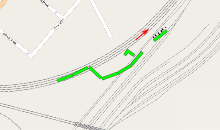
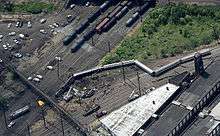
At about 9:10 p.m. (EDT) on May 12, 2015, Amtrak's northbound Northeast Regional No. 188 departed Philadelphia's 30th Street Station en route from Washington, D.C., to New York City. [2][6][7] The train consisted of seven cars hauled by a year-old Amtrak Cities Sprinter (ACS)-64 locomotive, No. 601. The engineer was Brandon Bostian, who had begun working the route a few weeks prior.[8]
The train entered a four-degree left curve on the four-track line[9] at the railroad's Frankford Junction in the Port Richmond neighborhood of Philadelphia, Pennsylvania, near the intersection of Frankford Avenue and Wheatsheaf Lane, and it derailed and crashed at 9:23 p.m.(EDT).[10] Passengers reported that the front of the train shook at first, then came to a sudden stop.[11] The entire train went off the track, with three cars rolling onto their sides.[12][13][14]
The manually controlled train should have been slowing to approach the curve with a reduced speed limit of 80 mph (130 km/h) in its approach and 50 mph (80 km/h) within it,[2][13][15][16] but instead, it had accelerated into the curve and was traveling at 106 mph (171 km/h) when its engineer[8] applied the emergency brake, and 102 mph (164 km/h) when it derailed,[17] according to Robert L. Sumwalt, the National Transportation Safety Board's lead investigator, who cited the onboard event recorder recovered from the wreckage. Investigators are working to determine why the train entered the curve too fast. The windshield of the locomotive may have been hit by a projectile shortly before the derailment.[18]
Although the train was controlled manually, it had been equipped with positive train control (PTC), which can automatically stop a train or slow it to a safe speed regardless of engineer input. Amtrak officials said PTC had been installed on the tracks ahead of a Congress-mandated December 2015 deadline, but had yet to be operational due to "budgetary shortfalls, technical hurdles and bureaucratic rules". For four years, the railroad struggled with the FCC to purchase the rights to airwaves in the Northeast Corridor required for PTC,[19] which might have limited the train's speed and thereby prevented the crash. During a press conference, NTSB member Robert Sumwalt told reporters, "Based on what we know right now, we feel that had such a system been installed in this section of track, this accident would not have occurred."[20][21][22] The track in question was not equipped with ATC (Automatic Train Control), which had been operational for years on the southbound track of the curve at which the derailment occurred, and which also would have limited the train's speed entering the curve. Shortly after the derailment, Amtrak completed that ATC installation on the northbound track.[4]
This fatal derailment was the second at Frankford Junction. On September 6, 1943, on the same tracks and within two blocks of the 2015 crash site, an extra section of the Congressional Limited, then the Pennsylvania Railroad's premier Washington-to-New York service, derailed approaching the same curve en route to New York, killing 79 people and injuring 117 others.[23]
Immediate aftermath
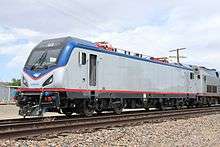
Some passengers were able to walk off the train, while others needed to be rescued with cutting tools.[24] Eventually, a crane was brought to the site to lift the overturned train cars, in part to search for trapped victims.[2][6]
More than 200 passengers were treated at area hospitals, including Temple University Hospital, Aria Health, Hahnemann University Hospital, Jefferson University Hospital, and Einstein Medical Center. Most of the injured passengers sustained minor lacerations and contusions, while some also had fractured bones; 11 were critically injured.[2][25] Bostian, the engineer, survived the crash with leg injuries, a concussion, and a head wound.[1][25][26]
Eight passengers died, including one at Temple University Hospital.[1][14] The dead were Jim Gaines, a software architect;[2] Abid Gilani, a business executive; Bob Gildersleeve, who worked for a chemical and soap supplier; Derrick Griffith, a dean for student affairs at City University of New York Medgar Evers College; Rachel Jacobs, CEO of ApprenNet, an educational technology startup company; Justin Zemser, a midshipman at the United States Naval Academy; Laura Finamore, managing director of a Manhattan real estate firm; and Giuseppe Piras, a Sardinian businessman visiting the United States to promote his family's olive oil business.[27][28]
Another passenger, former Congressman Patrick Murphy, said: "There was a lot of mayhem. A lot of blood, a lot of bleeding. I pulled myself up. The guy who I kind of landed on was OK. The guy next to him was completely passed out, knocked unconscious. People were pretty banged up." He said that after the train derailed, there were loud banging sounds and the train was shaking. Murphy, who sustained minor injuries in the crash, helped other passengers leave the train.[6] The man seated next to Murphy eventually regained consciousness, walked off the train, and helped other passengers.[25] Delaware Senator Tom Carper had been on the same train, but got off at an earlier stop in Wilmington, Delaware.[29] Chef Eli Kulp was among the badly injured passengers.[30][31]
Paul Cheung, an Associated Press manager, was also on the train. He said that before the train derailed, it "started to decelerate, like someone had slammed the brake. Then suddenly you could see everything starting to shake. You could see people’s stuff flying over me."[6] Passenger Daniel Wetrin was taken to a nearby school after the crash. He said, "I walked off as if, like, I was in a movie. There were people standing around, people with bloody faces … power cables all buckled down as you stepped off the train."[6] Another man took a cell phone video of the crash's aftermath, in which rescuers are telling trapped passengers to crawl to safety, while other passengers cry and moan.[6] One Port Richmond resident said the crash felt like "a mild earthquake"; another said it "sounded like a bomb."[32]
Mass transit adjustments
- Amtrak service was suspended along the Northeast Corridor between New York City and Philadelphia.[33][34] Service resumed on May 18, 2015.[35]
- New Jersey Transit suspended service along the Atlantic City Line between Philadelphia and Cherry Hill. Service resumed on May 15, 2015.[36]
- SEPTA Regional Rail service on the Trenton Line and Chestnut Hill West Line was also suspended.[33][34] Service resumed on May 18, 2015.[37]
Regulatory response
On May 19, 2015, the Federal Railroad Administration issued an emergency order to Amtrak related to the derailment. It required Amtrak to modify its automatic train control system to enforce the passenger train speed limit on the curve where the derailment occurred, while noting that Amtrak had already implemented the changes at the time of the order. It also required Amtrak to identify other curves on the Northeast Corridor with a more than 20 mph drop in the authorized approach speed and carry out similar changes, and to install additional passenger train speed limit signage.[38][39]
Investigation
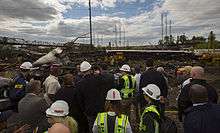
After an initial investigation of the scene, the Federal Bureau of Investigation (FBI) said there was not any indication that the derailment was terrorism-related.[6][40] An NTSB team also investigated.[11] Preliminary information suggested that the derailment was accidental, according to informal statements made by both agencies, which continue to investigate.[34][41] However, by early June authorities admitted that they still could not understand the reason for the incident.[42] Investigators are focusing on why the train entered the curve too fast; it passed 70 mph (110 km/h) at 65 seconds before the crash, 100 mph (160 km/h) just 16 seconds before, and the emergency brake was applied just seconds before the crash.[43][44] All of the locomotives' controls could only be manipulated manually by the engineer when it derailed. The engine was not aging equipment as it was only a year old and had no reported history of unintended acceleration.[43] Bostian was not talking on the phone, texting or using smartphone data during the accident. The NTSB has told Congress that human error is a likely factor.[45]
Amtrak engineer Brandon Bostian's lawyer said that his client does not recall much about the accident because of a concussion he sustained in the crash, but that "he remembers coming into curve. He remembers attempting to reduce speed and thereafter he was knocked out."[44] The NTSB interviewed Bostian on May 15, who said he had "no recollection" of events after the train passed North Philadelphia station. Lead NTSB investigator Robert Sumwalt said Bostian was "extremely cooperative".[46] Earlier, Sumwalt had said, "for somebody who's been through a traumatic event, this is not at all unusual for human behavior to have the mind blank out things like that, at least for the short term."[1][26][47]
According to The New York Times Magazine, investigators are focusing on two possibilities: that a rock hit the windshield of the locomotive and caused Bostian to be distracted or disoriented, or that he mistakenly believed he was in a different curve. Both would result in Bostian losing situational awareness and allowing the train to enter the curve too fast.[48]
Response of politicians

Philadelphia Mayor Michael Nutter said of the crash, "It is an absolute disastrous mess."[6] Pennsylvania Governor Tom Wolf said, "Anything that the state can do, we stand ready to do that."[6] Amtrak was "deeply saddened by the loss of life from Amtrak Northeast Regional Train 188," according to a statement released on May 13.[6] Vice President Joe Biden said, "Amtrak is like a second family to me, as it is for so many other passengers." He said he had taken about 8,000 Amtrak trips to and from Washington during his career.
President Barack Obama, in his statement following the accident, said:
Along with Americans across our country, Michelle and I were shocked and deeply saddened to hear of the derailment aboard Amtrak Train 188. Our thoughts and prayers go out to the families and friends of those we lost last night, and to the many passengers who today begin their long road to recovery. Along the Northeast Corridor, Amtrak is a way of life for many. From Washington, DC and Philadelphia to New York City, this is a tragedy that touches us all. As we work to determine exactly what happened, I commend the fire, police and medical personnel working tirelessly and professionally to save lives. Philadelphia is known as the city of brotherly love – a city of neighborhoods and neighbors – and that spirit of loving-kindness was reaffirmed last night, as hundreds of first responders and passengers lent a hand to their fellow human beings in need.[49]
The day following the derailment, the U.S. House Appropriations Committee passed a measure to cut $260 million from Amtrak's $1.36 billion budget for the next fiscal year. Democrat Nita Lowey said, "While we don't know the cause of this accident, we do know that starving rail of funding will not enable safer train travel." In the same meeting, some Republicans criticized Democrats for linking the budget to the crash. Idaho Rep. Mike Simpson admonished the Democrats for taking advantage of the situation, saying, "Don't use this tragedy in that way. It was beneath you."[50][51][52]
Cause
At a hearing on May 17, 2016, the National Transportation Safety Board reported that the primary cause of the derailment was a loss of situational awareness by the train's operator, likely caused by distracting radio chatter from a nearby SEPTA train that had experienced an emergency situation. This distraction resulted in the operator believing he was further down the track than he was, thus accelerating the train before the curve rather than after it. The board concluded that the accident would have been entirely prevented if the line was equipped with positive train control, which would have recognized and applied the appropriate speed limit, and chairman Christopher A. Hart called on federal railroad regulators to "end this list of PTC preventable fatalities and injuries right now."[53]
Resulting changes
As a result of the derailment and in particular the inability of the engineer to remember the crash, Amtrak installed inward-facing cameras in its locomotives in 2015 and 2016, recording the actions of engineers before any future accidents.[54] Amtrak completed installation of the ACSES positive train control system on the entire Northeast Corridor between Washington and Boston in December 2015.[55]
Litigation
While §161(a) of the "Amtrak Reform and Accountability Act of 1997" (ARAA)[56] capped the total liability (including for punitive damages) of Amtrak and all other defendants in any single passenger train accident at $200 million,[57][58] a Bill (S. 1360) introduced by US Senator Bill Nelson (D-FL) on May 18, 2015 would if passed raise that limit to $500 million retroactive to May 12, 2015, the date of the Philadelphia derailment.[59][60] If the ARAA imposed statutory liability limit proves insufficient to cover all damages and it is not raised by Congress, however, some plaintiffs' attorneys have already stated that the constitutionality of the $200 million cap would be challenged.[61]
In early July, 2015 both Amtrak and the plaintiffs in the multiple Federal civil lawsuits filed against the company in US District Courts in Pennsylvania, New York and New Jersey requested that all then existing and future such actions be transferred to and heard in the Eastern District of Pennsylvania (EDPA) in Philadelphia under the management of the Judicial Panel on Multidistrict Litigation (MDL) as provided for by 28 U.S.C. §1407[62] as a centralized process to considerably speed up litigation by conserving the resources of the parties and judiciary, avoiding duplication of discovery, and preventing inconsistent pretrial rulings.[63][64] All the consolidated cases have been assigned to U.S. District Judge Legrome D. Davis.[65][66] In answers filed by Amtrak with that Court on July 10, 2015 in response to the first two passenger lawsuits[67] the company admitted fault by stipulating[68] as "true"[69] that the train was "traveling in excess of the allowable speed" when it derailed and thus Amtrak "will not contest liability for compensatory damages proximately caused by the derailment of Train 188 on May 12, 2015".[70] April 6th 2016, a Pennsylvania federal judge on Wednesday refused to grant settlement class certification to two passengers suing Amtrak over a train’s derailment last year in Philadelphia, ruling that damages capped at $295 million would likely be reduced in related multidistrict litigation, according to Plaintiff Attorney Evan K Aidman. [71]
See also
References
- 1 2 3 4 5 Stolberg, Sheryl Gay; Flegenheimer, Matt; Pérez-Peña, Richard (May 14, 2015). "Brandon Bostian Agrees to Talk About Amtrak Derailment but May Recall Little". The New York Times. Retrieved May 18, 2015.
- 1 2 3 4 5 6 "7 killed in Philadelphia Amtrak crash; engineer ID'd". 6abc.com. Philadelphia, PA: WPVI-TV. May 13, 2015. Retrieved May 13, 2015.
- ↑ "The century-old tech that ensures train safety". Fortune.com. 2015-07-24. Retrieved 2015-12-21.
- 1 2 Gray, Melissa (May 17, 2015). "Amtrak installs speed controls at fatal crash site". CNN.
- ↑ Gambardello, Joseph A. (May 13, 2015). "Investigators Headed to Port Richmond to Probe Deadly Derailment". The Philadelphia Inquirer.
- 1 2 3 4 5 6 7 8 9 10 "Amtrak Philadelphia train crash: mayor describes 'disastrous mess'". The Guardian. May 13, 2015. Retrieved May 13, 2015.
- ↑ "'Heartbroken': 6 dead, hundreds injured after Amtrak train derails in Philadelphia". CNN.com. CNN. Retrieved May 13, 2015.
- 1 2 Laughlin, Jason; Finley, Ben (May 16, 2015). "For Train 188 engineer, a solitary but dream job". The Philadelphia Inquirer. Retrieved May 19, 2015.
- ↑ Brotzman, Chris. "Shore tower". Retrieved May 13, 2015.
- ↑ Keneally, Meghan (May 13, 2015). "Amtrak Derailment: Video Shows the Harrowing Moments Before the Crash". ABC News. Retrieved May 13, 2015.
- 1 2 "Amtrak train derails, killing 5 people; cars ripped apart". Associated Press. May 13, 2015. Retrieved May 13, 2015.
- ↑ "Amtrak train derails in Philadelphia". CNN. May 13, 2015. Retrieved May 13, 2015.
- 1 2 Mann, Ted; Tangel, Andrew; Maher, Kris (May 13, 2015). "Amtrak Crash: Train Appears to Have Hit Curve Going Over 100 MPH". The Wall Street Journal. Retrieved May 13, 2015.
- 1 2 "US Amtrak New York-bound train derails in Philadelphia". BBC. Retrieved May 13, 2015.
- ↑ "NTSB: Engineer Hit Emergency Brake as Train Traveled 100+ MPH Moments Before Deadly Derailment". nbcphiladelphia.com. nbcphiladelphia.com. May 13, 2015. Retrieved May 13, 2015.
- ↑ "Northeast Corridor Employee Timetable #5" (PDF). National Railroad Passenger Corporation (Amtrak). 6 October 2014. Archived from the original (PDF) on February 3, 2016 – via National Transportation Safety Board.
- ↑ Zauzmer, Julie; Halsey III, Ashley; Shapiro, T. Rees (May 13, 2015). "Train approached curve at 106 mph, twice the limit". The Washington Post. Retrieved July 4, 2015.
- ↑ Renshaw, Jarrett (May 16, 2015). "Philadelphia train may have been hit by projectile before wreck". Reuters. Retrieved May 16, 2015.
- ↑ Shear, Michael D.; Mouawad, Jad (May 14, 2015). "Amtrak Says Shortfalls and Rules Delayed Its Safety System". nytimes.com. The New York Times Company. Retrieved May 15, 2015.
- ↑ Shoichet, Catherine E. (May 13, 2015). "Amtrak derailment: Could technology have stopped the crash?". CNN.com. CNN. Retrieved May 13, 2015.
- ↑ Rucker, Patrick; Renshaw, Jarrett (May 13, 2015). "Derailed Amtrak train lacked latest U.S. safety controls". Reuters. Retrieved May 13, 2015.
- ↑ "As Train Crash Death Toll Reaches 7, GOP Votes to Cut Amtrak Budget by $250M & Delay Safety Upgrades". Democracy Now!. May 14, 2015. Retrieved May 14, 2015.
- ↑ Barletta, Ferruccio. "INTERSTATE COMMERCE COMMISSION INVESTIGATION NO. 2726 THE PENNSYLVANIA RAILROAD COMPANY REPORT IN RE ACCIDENT AT SHORE PA., ON SEPTEMBER 6, 1943". dot.gov. Retrieved May 13, 2015.
- ↑ "5 dead, at least 50 injured after Amtrak train derails in Philadelphia". CNN. May 13, 2015. Retrieved May 13, 2015.
- 1 2 3 "Amtrak Crash: Investigators Recover Train's Black Box, Probe Continues". ABC News via Good Morning America. May 13, 2015. Retrieved May 13, 2015.
- 1 2 Philipps, Dave; Fitzsimmons, Emma G. (May 14, 2015). "For Amtrak Engineer Brandon Bostian, Childhood Passion Became A Career". New York Times. Retrieved May 14, 2015.
- ↑ Yee, Vivian (May 14, 2015). "Eight Amtrak Passengers' Deaths Echo Across the Region and the World". New York Times. Retrieved May 19, 2015.
- ↑ "Who were the victims of the Amtrak derailment?". CNN. May 14, 2015. Retrieved May 14, 2015.
- ↑ "Amtrak train derails killing 6 people; investigation begins". msn.com. Retrieved May 13, 2015.
- ↑ Hilario, Fran (19 May 2015). "Chef Eli Kulp remains hospitalized after Amtrak derailment". Philadelphia Business Journal. Retrieved 9 June 2015.
- ↑ Klein, Michael (13 May 2015). "Chef Eli Kulp injured in Amtrak derailment". Philadelphia Inquirer. Retrieved 9 June 2015.
- ↑ "At least seven killed in Amtrak train crash in Philadelphia; over 200 treated at hospitals". PhillyVoice. May 13, 2015. Retrieved May 13, 2015.
- 1 2 "Amtrak derailment impacts SEPTA, other transit". Philadelphia, PA: WPVI-TV. May 13, 2015. Retrieved May 13, 2015.
- 1 2 3 "At Least 7 Dead, Over 200 Hurt After Amtrak Train Derails, Rolls on Side in Philadelphia". nbcphiladelphia.com. Philadelphia, PA: WCAU-TV. May 13, 2015. Retrieved May 14, 2015.
- ↑ Shapiro, Emily (May 17, 2015). "Amtrak Service Returns Monday Between New York and Philadelphia". ABC News. ABC News. Retrieved May 18, 2015.
- ↑ "Train : Atlantic City Line : Travel Alerts". New Jersey Transit. New Jersey Transit. May 17, 2015. Retrieved May 18, 2015.
- ↑ "Alerts: Regional Rail". SEPTA: Southeastern Pennsylvania Transportation Authority. SEPTA. Retrieved May 18, 2015.
- ↑ "Amtrak 188 wreck: FRA Emergency Order; windshield strike possible factor". Railway Age. May 19, 2015. Retrieved June 7, 2015.
- ↑ "Emergency Order under 49 U.S.C. 20104 Establishing Requirements for the National Railroad Passenger Corporation to Control Passenger Train Speeds at Certain Locations Along the Northeast Corridor". fra.dot.gov. Federal Railroad Administration. May 21, 2015.
- ↑ "FBI: No indication of terrorism in Amtrak train derailment". CNN. May 12, 2015. Retrieved May 12, 2015.
- ↑ "Philadelphia Train Crash: Six Dead, Scores Hurt Aboard Amtrak Service". NBC News. May 13, 2015. Retrieved May 13, 2015.
- ↑ Nixon, Ron (2015-06-02). "Cause of Amtrak Train's Speeding Still Unknown, Panel Is Told". The New York Times. ISSN 0362-4331. Retrieved 2015-11-04.
- 1 2 "Amtrak train rapidly accelerated seconds before crash". CBS News. May 15, 2015. Retrieved May 19, 2015.
- 1 2 Kennedy, Suzanne (May 14, 2015). "Amtrak train engineer doesn't remember deadly wreck, says lawyer". Associated Press. Retrieved May 20, 2015.
- ↑ No Evidence That Amtrak Engineer Used Phone During Crash, Safety Board Says, The New York Times, 11 June 2015
- ↑ Smith, Paul (May 15, 2015). "NTSB talks with engineer of derailed Amtrak train". WPMT. Retrieved May 16, 2015.
- ↑ Badia, Erik; Marcus, Chelsia Rose; McShane, Larry (May 15, 2015). "Engineers discuss train hit by object before derailment". NYDailyNews.com. Retrieved May 16, 2015.
- ↑ Shaer, Matthew (January 26, 2016). "The Wreck of Amtrak 188". The New York Times. Retrieved January 27, 2016.
- ↑ "Statement by the President". whitehouse.gov. May 13, 2015. Retrieved May 13, 2015.
- ↑ Caygle, Heather (May 13, 2015). "House panel votes to cut Amtrak budget hours after deadly crash". politico.com. Retrieved May 14, 2015.
- ↑ Taylor, Andrew (May 13, 2015). "House GOP Blocks Hike in Amtrak Budget Hours After Crash". NBC Philadelphia. Retrieved May 13, 2015.
- ↑ "House committee passes bill that cuts Amtrak funding after crash". CNN. May 13, 2015. Retrieved May 13, 2015.
- ↑ Recap: NTSB hearing on Amtrak derailment. Philly.com, 17 May 2016
- ↑ http://philadelphia.cbslocal.com/2015/05/26/amtrak-to-install-long-sought-cameras-in-locomotives-following-deadly-derailment/
- ↑ http://www.railwayage.com/index.php/ptc/acses-fully-operational-on-the-nec.html
- ↑ "Amtrak Reform and Accountability Act of 1997" PL 105–134—Dec. 2, 1997
- ↑ 49 U.S. Code § 28103(a)(2) Title 49, Subtitle V - RAIL PROGRAMS, Part E, Chapt. 281, § 28103 - Limitations on rail passenger transportation liability: "(a)(2) The aggregate allowable awards to all rail passengers, against all defendants, for all claims, including claims for punitive damages, arising from a single accident or incident, shall not exceed $200,000,000."
- ↑ Pearson, Sophie Amtrak Train Crash Victims Face $200 Million Injuries Cap Bloombrg Business, May 14, 2015
- ↑ "Senate Bill Would Raise Passenger Railroad Liability Limit" The Claims Journal, May 22, 2015
- ↑ S. 1360 "A Bill to amend the limitation on liability for passenger rail accidents or incidents under section 28103 of title 49, United States Code, and for other purposes." Introduced May 18, 2015
- ↑ Voreacos, David & Pettersson, Edvard "Amtrak Admits Liability in Philadelphia Crash Cases" Claims Journal, July 13, 2015
- ↑ 28 U.S. Code § 1407 - Multidistrict litigation Legal Information Institute, Cornell University Law School
- ↑ D'Annunzio, P.J. "Amtrak Consents to Derailment MDL" The Legal Intelligencer, July 2, 2015
- ↑ "PLAINTIFFS’ MEMORANDUM IN SUPPORT OF MOTION FOR TRANSFER OF ACTIONS TO THE EASTERN DISTRICT OF PENNSYLVANIA PURSUANT TO 28 U.S.C. § 1407 FOR COORDINATED OR CONSOLIDATED PRETRIAL PROCEEDINGS" In re: Amtrak Train Derailment in Philadelphia, PA, on May 12, 2015, Before the United States Judicial Panel on Multidistrict Litigation, Case MDL No. 2654 Document 1-1, June 22, 2015
- ↑ Stemple, Jonathan "Amtrak seeks to combine lawsuits over fatal Philadelphia derailment" Reuters, July 1, 2015
- ↑ D'Annuzio, PJ "Judge Handling Amtrak Cases Known for Intellect, Empathy" The Legal Intelligencer June 9, 2015
- ↑ Blair Berman v. National Railroad Passenger Corporation (Amtrak), EDPA No. 2:2015cv2741; Felicidad R. Iban, et. al. v. National Railroad Passenger Corporation (Amtrak), EDPA No. 2:2015cv02744
- ↑ "Stipulation" Legal Dictionary, thefreedictionary.com
- ↑ Federal Rules of Civil Procedure Title III, Rule 8(b)(4) "Denying Part of an Allegation: A party that intends in good faith to deny only part of an allegation must admit the part that is true and deny the rest."
- ↑ Nixon, Ron "Amtrak Will Not Fight Suits Filed in Wreck" The New York Times, July 10, 2015
- ↑ http://www.law360.com/cases/561d5bb621fb2a354c000007
Further reading
- National Transportation Safety Board (June 2, 2015). Preliminary Report Railroad DCA15MR010 (Report). National Transportation Safety Board.
- Shaer, Matthew (January 26, 2016). "The Wreck of Amtrak 188". The New York Times.
External links
| Wikimedia Commons has media related to 2015 Philadelphia train derailment. |
- Amtrak derailment in Philadelphia, PA – NTSB
- "Amtrak Derailment", House Transportation and Infrastructure Committee hearing, June 2, 2015, as recorded by C-SPAN